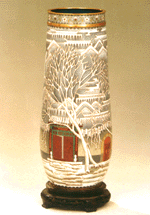 A few factors combine to make cloisonne, an enamel finish using wires to separate different colors, unique.
A few factors combine to make cloisonne, an enamel finish using wires to separate different colors, unique.
First, it is Chinese, although some claim it has some Byzantine influence with Mongol expedition forces as the medium in the 14th century.
It is beautiful, if you like elaborate beauty. It is also highly decorative.
It was during the reign of the Ming Dynasty Emperor Jingtai (1450-57) that cloisonne and the technology used in making it prospered in China.
Of everything made using the technique, blue pieces were considered to be the best. Hence the Chinese name Jingtailan, or Emperor Jingtai's Blue.
The old craft has been handed down from generation to generation and improved and upgraded with the passage of time. Cloisonne pieces have been frequently given to foreign leaders as the gifts of the Chinese Government since the People's Republic of China was founded in 1949.
Making a cloisonne piece is extremely complicated.
First, the copper base has to be forged into the shape it will end up as - a vase, a bowl, or a screen, for example. If the piece is very large, say, a gigantic vase, a number of copper pieces need to be first forged into the desired shapes and then welded together.
Then comes the insetting of the wires. Artisans inset copper wire onto the surface to form elaborate patterns and images.
The copper base is then sent to a stove to be fired and the base and patterns are made into the whole thing. The piece is then cleaned to get rid of all residue and dirt. Chemicals are applied.
The next stage is the colouring. Special paints of various colours are applied to fill the small compartments formed by the wires. Paint has to be repeatedly applied to fill up the compartments and really flesh out the whole piece.
The final stage is the polishing. This is done to smooth the surface and bring out the patterns. Now the wires are no longer sheer wires, they are shiny, curving lines that outline the images and patterns. The piece is completed.
Traditionally, the images and patterns symbolize good luck and fortune, flowers, birds, beauty and so on.
Now, in order to better cater for the tastes of people today, the Beijing Enamel Factory has come up with a series of modern cloisonne ware. These kinds of products generally have simple shapes, light colors and more casual images.
An Islam and an American series have also been developed to better accommodate overseas customers.
"Our factory turns out the best cloisonne ware in the country because it imposes the strictest quality control measures," said Yuan Jizhen, the factory director. "We have the best designers and artisans gathered in our factory."
The factory's products are sold largely in Hong Kong, the United States and other parts of the world.
"In San Francisco's Chinatown, for example, cloisonne ware made by our factory can be found everywhere," he said. But the factory is paying a price for being the best and most prestigious.
Second-rate cloisonne piece copies are flooding the market because they are much cheaper and look much the same as the factory's from a distance.
Family-run workshops in Sanhe, Dachang and other counties in Hebei Province, surrounding Beijing, are turning out large amounts of copy cloisonne ware, making the going increasingly tough for the Beijing Enamel Factory.
"Their advantage is that they don't have to worry about the quality, the design, or the materials. All they care about is copying our designs, or in some cases, come up with their own inferior designs, turning out a piece that looks like good cloisonne in the eyes of a layman and selling it at a low but still profitable price. Unfortunately the majority of cloisonne buyers are laymen," said Yi Fucheng, the factory's vice-director.
This not only affects the sales of genuine cloisonne made by regular manufacturers such as the Beijing Enamel Factory, but is also not in the interests of the buyers.
"Cheap as it is, a closer look would reveal serious defects in design, wire insetting, enamel filling and polishing. Why should a customer spend any money on a fake?" said Yuan.
(China Daily 05/10/2001)
